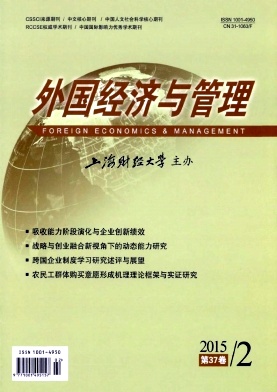跨国企业制度学习研究述评与展望
外国经济与管理 2015 年 第 37 卷第 02 期, 页码:29 - 37
摘要
参考文献
摘要
跨国企业在东道国市场需要面对的首要问题是与母国市场不同的制度环境,由此产生的制度距离及制度学习问题成为学者关注的重点。本文在梳理相关文献的基础上,从跨国企业制度学习相关概念演进、方式路径探索、制度学习效果度量等方面对现有研究进行系统评述,并就未来相关探究方向及重点予以展望,以供后续研究及我国企业国际化实践参考。
[1]Ando N.The ownership structure of foreign subsidiaries and the effect of institutional distance:A case study of Japanese firms[J].Asia Pacific Business Review,2012,18(2):259-274.
[2]Demirbag M,et al.Perceptions of institutional environment and entry mode[J].Management International Review,2010,50(2):207-240.
[3]Eriksson K,et al.Experiential knowledge and cost in the internationalization process[J].Journal of International Business Studies,1997,28(2):337-360.
[4]Eriksson K,et al.Path dependence and knowledge development in the internationalization process[J].Management International Review,2000,40(4):307-328.
[5]Eriksson K,et al.Effect of variation on knowledge accumulation in the internationalization process[J].International Studies of Management and Organization,2000,30(1):26-44.
[6]Fletcher M and Harris S.Knowledge acquisition for the internationalization of the smaller firm:Content and sources[J].International Business Review,2012,21(4):631-647.
[7]Granovetter M.Economic institutions as social constructions:A framework for analysis[J].Acta Sociologica.1992,35(1):3-11.
[8]Hochberg Y V,et al.Networking as a barrier to entry and the competitive supply of venture capital[J].The Journal of Finance,2010,65(3):829-859.
[9]Johanson J and Wiedershim P F.The internationalization of the firm—Four Swedish cases[J].Journal of Management Studies,1975,12(3):305-322.
[10]Johanson J and Vahlne J-E.The internationalization process of the firm—A model of knowledge development and increasing foreign market commitment[J].Journal of International Business Studies,1977,8(1):23-32.
[11]Johanson J and Mattsson L-G.Internationalization in industrial systems—A network approach[A].In Hood N and Vahlne J-E(eds.).Strategies in Global Competition[C].London:Croon Helm,1988,287-314.
[12]Johanson J and Vahlne J-E.The mechanism of internationalization[J].International Marketing Review,1990,7(4):11-24.
[13]Johanson J and Vahlne J-E.Business relationship learning and commitment in the internationalization process[J].Journal of International Entrepreneurship,2003,1(1):83-102.
[14]Johanson J and Vahlne J-E.Commitment and opportunity development in the internationalization process:A note on the Uppsala internationalization process model[J].Management International Review,2006,46(2):165-178.
[15]Xu K and Michael A H.Entry mode and institutional learning:A polycentric perspective[J].Advances in International Management,2012,25:149-178.
[16]Lin Z J,et al.How do networks and learning drive M&As?An institutional comparison between China and the United States[J].Strategic Management Journal,2009,30(10):1113-1132.
[17]Markus M M and Markku V J M.Cross-border venture capital and new venture internationalization:An isomorphism perspective[J].Venture Capital:An International Journal of Entrepreneurial Finance,2005,7(3):227-257.
[18]Michael A H,et al.Emerging Markets as Learning Laboratories:Learning Behavior of Local Firms and Foreign Entrants in Different Institutional Contexts[J].Management and Organization Review,2005,1(3):353-380.
[19]Oviatt B M and McDougall P P.The internationalization of entrepreneurship[J].Journal of International Business Studies,2005,36(1):2-8.
[20]Peng M W and Heath P S.The growth of the firm in planned economies in transition:Institutions,organizations,and strategic choice[J].Academy of Management Review,1996,21(2):492-528.
[21]Davis P,et al.Francis.Mode of international entry:An isomorphism perspective[J].Journal of International Business Studies,2000,31(2):239-258.
[22]Tseng J J and Chou P H.Mimetic isomorphism and its effect on merger and acquisition activities in Taiwanese financial industries[J].The Service Industries Journal,2011,31(9):1451-1469.
[23]Tsai K S.Adaptive informal institutions and endogenous institutional change in China[J].World Politics,2006,59(1):116.
[24]Henisz W J and Bennet A Z.Legitimacy,interest group pressures,and change in emergent institutions:The case of foreign investors and host country governments[J].Academy of Management Review,2005,30(2):361-382.
[25]Xia J,et al.When experience meets national institutional environmental change:Foreign entry attempts of US firms in the central and eastern European region[J].Strategic Management Journal,2009,30(12):1286-1309.
[26]李军,王玉荣.制度学习、网络中心性和市场进入——跨国风险资本在华投资的实证研究[J].国际贸易问题,2013,(1):131-145.
[27]蒋冠宏,蒋殿春.中国对发展中国家的投资——东道国制度重要吗?[J].管理世界,2012(11):45-56.
[28]任兵,郑莹.外来者劣势研究前沿探析与未来展望[J].外国经济与管理,2012,34(2):27-34.
[29]吴晓波,高钰,窦伟.中国民营企业跨国投资距离对海外子公司多元化影响的实证分析[J].浙江学刊,2012,(6):183-188.
[30]薛有志,刘鑫.国外制度距离研究现状探析与未来展望[J].外国经济与管理,2013,35(3):28-36.
[31]阎大颖.制度距离、国际经验与中国企业海外并购的成败问题研究[J].南开经济研究,2011,(5):75-97.
[32]章进.基于知识基础理论的企业国际化进程研究——国际化知识的外部获取以及网络获取[J].经济师,2006,(5):37-38.
[33]周劲波,黄胜.关系网络视角下的国际创业研究述评[J].外国经济与管理,2013,35(2):22-33.
[2]Demirbag M,et al.Perceptions of institutional environment and entry mode[J].Management International Review,2010,50(2):207-240.
[3]Eriksson K,et al.Experiential knowledge and cost in the internationalization process[J].Journal of International Business Studies,1997,28(2):337-360.
[4]Eriksson K,et al.Path dependence and knowledge development in the internationalization process[J].Management International Review,2000,40(4):307-328.
[5]Eriksson K,et al.Effect of variation on knowledge accumulation in the internationalization process[J].International Studies of Management and Organization,2000,30(1):26-44.
[6]Fletcher M and Harris S.Knowledge acquisition for the internationalization of the smaller firm:Content and sources[J].International Business Review,2012,21(4):631-647.
[7]Granovetter M.Economic institutions as social constructions:A framework for analysis[J].Acta Sociologica.1992,35(1):3-11.
[8]Hochberg Y V,et al.Networking as a barrier to entry and the competitive supply of venture capital[J].The Journal of Finance,2010,65(3):829-859.
[9]Johanson J and Wiedershim P F.The internationalization of the firm—Four Swedish cases[J].Journal of Management Studies,1975,12(3):305-322.
[10]Johanson J and Vahlne J-E.The internationalization process of the firm—A model of knowledge development and increasing foreign market commitment[J].Journal of International Business Studies,1977,8(1):23-32.
[11]Johanson J and Mattsson L-G.Internationalization in industrial systems—A network approach[A].In Hood N and Vahlne J-E(eds.).Strategies in Global Competition[C].London:Croon Helm,1988,287-314.
[12]Johanson J and Vahlne J-E.The mechanism of internationalization[J].International Marketing Review,1990,7(4):11-24.
[13]Johanson J and Vahlne J-E.Business relationship learning and commitment in the internationalization process[J].Journal of International Entrepreneurship,2003,1(1):83-102.
[14]Johanson J and Vahlne J-E.Commitment and opportunity development in the internationalization process:A note on the Uppsala internationalization process model[J].Management International Review,2006,46(2):165-178.
[15]Xu K and Michael A H.Entry mode and institutional learning:A polycentric perspective[J].Advances in International Management,2012,25:149-178.
[16]Lin Z J,et al.How do networks and learning drive M&As?An institutional comparison between China and the United States[J].Strategic Management Journal,2009,30(10):1113-1132.
[17]Markus M M and Markku V J M.Cross-border venture capital and new venture internationalization:An isomorphism perspective[J].Venture Capital:An International Journal of Entrepreneurial Finance,2005,7(3):227-257.
[18]Michael A H,et al.Emerging Markets as Learning Laboratories:Learning Behavior of Local Firms and Foreign Entrants in Different Institutional Contexts[J].Management and Organization Review,2005,1(3):353-380.
[19]Oviatt B M and McDougall P P.The internationalization of entrepreneurship[J].Journal of International Business Studies,2005,36(1):2-8.
[20]Peng M W and Heath P S.The growth of the firm in planned economies in transition:Institutions,organizations,and strategic choice[J].Academy of Management Review,1996,21(2):492-528.
[21]Davis P,et al.Francis.Mode of international entry:An isomorphism perspective[J].Journal of International Business Studies,2000,31(2):239-258.
[22]Tseng J J and Chou P H.Mimetic isomorphism and its effect on merger and acquisition activities in Taiwanese financial industries[J].The Service Industries Journal,2011,31(9):1451-1469.
[23]Tsai K S.Adaptive informal institutions and endogenous institutional change in China[J].World Politics,2006,59(1):116.
[24]Henisz W J and Bennet A Z.Legitimacy,interest group pressures,and change in emergent institutions:The case of foreign investors and host country governments[J].Academy of Management Review,2005,30(2):361-382.
[25]Xia J,et al.When experience meets national institutional environmental change:Foreign entry attempts of US firms in the central and eastern European region[J].Strategic Management Journal,2009,30(12):1286-1309.
[26]李军,王玉荣.制度学习、网络中心性和市场进入——跨国风险资本在华投资的实证研究[J].国际贸易问题,2013,(1):131-145.
[27]蒋冠宏,蒋殿春.中国对发展中国家的投资——东道国制度重要吗?[J].管理世界,2012(11):45-56.
[28]任兵,郑莹.外来者劣势研究前沿探析与未来展望[J].外国经济与管理,2012,34(2):27-34.
[29]吴晓波,高钰,窦伟.中国民营企业跨国投资距离对海外子公司多元化影响的实证分析[J].浙江学刊,2012,(6):183-188.
[30]薛有志,刘鑫.国外制度距离研究现状探析与未来展望[J].外国经济与管理,2013,35(3):28-36.
[31]阎大颖.制度距离、国际经验与中国企业海外并购的成败问题研究[J].南开经济研究,2011,(5):75-97.
[32]章进.基于知识基础理论的企业国际化进程研究——国际化知识的外部获取以及网络获取[J].经济师,2006,(5):37-38.
[33]周劲波,黄胜.关系网络视角下的国际创业研究述评[J].外国经济与管理,2013,35(2):22-33.
引用本文
刘娟. 跨国企业制度学习研究述评与展望[J]. 外国经济与管理, 2015, 37(2): 29–37.
导出参考文献,格式为:





 6118
6118  672
672

